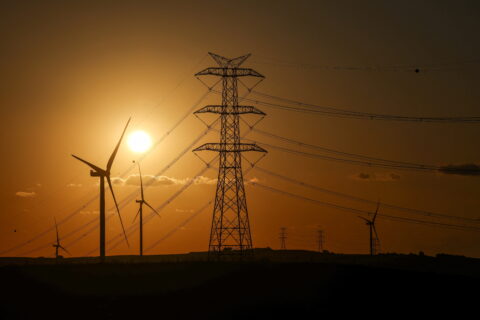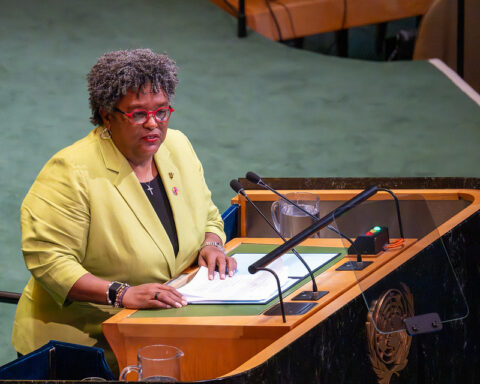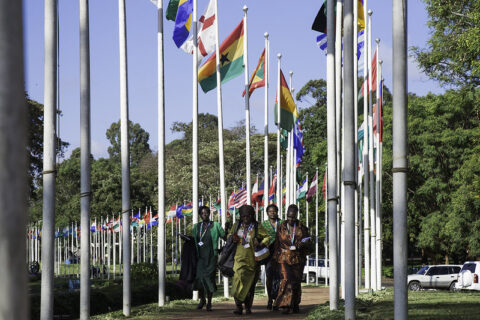Panama’s environment minister has joined a growing push for reform of the UN climate change negotiations, proposed by campaigners and academics in recent years – one of the first such calls by a minister directly involved in the talks.
Juan Carlos Navarro told Climate Home in a recent interview on the sidelines of Climate Week in New York that the current system for approving decisions – which requires all countries to agree by consensus – has not delivered good enough results and should instead use a majority or super-majority decision-making process.
“By consensus, you cannot get 186 nations to agree on anything. It’s a miracle we have come so far,” said Navarro. “We need to change the rules so we have a basic, rational, majority or super-majority decision-making process where we can do things better and faster.”
The comments follow pressure from civil society and academics to reform the UN climate process. In June, more than 200 campaign groups issued a joint call to reform the decision-making process, which they argued can be blocked by oil and gas-producing countries and has reached a “breaking point”.
Andreas Sieber, policy director with climate advocacy group 350.org, said he was sympathetic to Panama’s proposal, but added “it would just be part of a puzzle” to make the UN climate talks work more efficiently.
He added that it could be hard to get over the line as earlier efforts to secure a rule on voting as a last resort had met with fierce opposition from oil-producing countries – and decisions reached by consensus have the weight of having all the countries behind them, he noted.
Erika Lennon, Senior Attorney at the Center for International Environmental Law, celebrated that more people are talking about potential changes to the UNFCCC, as “being totally beholden to consensus-based decision making is not leading to the outcomes that we need”.
She also agreed that voting is just part of the solution, and suggested possible reforms could include increased transparency in the negotiation rooms, inclusion of civil society and indigenous groups, and a conflict of interest rule that blocks fossil fuel companies from participating.
During last year’s COP29 in Baku, a group of experts known as the Club of Rome – among them the former UN climate chief Christiana Figueres and former UN Secretary-General Ban Ki Moon – issued an open letter proposing ways to modernise the climate process.
The current structure of COPs “simply cannot deliver the change at exponential speed and scale, which is essential to ensure a safe climate landing for humanity”, the letter said. They argued instead for “smaller, more frequent, solution-driven meetings” where countries can discuss progress and be held accountable.
At that same COP in Azerbaijan, Saudi Arabia managed to block all mentions of fossil fuels in text summarising discussions on cutting greenhouse gas emissions. It was able to do this despite all countries having agreed to transition away from fossil fuels in energy systems just one year earlier at COP28.
UN Climate Change consults on COP process
In a speech at Climate Week in New York, Simon Stiell, the executive secretary of UN Climate Change, noted that recent COPs have delivered “concrete results and global steps forward”, adding that cooperation under the process has lowered expected global warming from 5C to closer to 3C.
But, he conceded, it is “imperfect”. “As this new era of implementation gathers pace, we must also keep evolving, and striving towards faster, fully-inclusive, higher-quality decisions that tie the formal process ever-closer to real economies and real lives,” he said.
Senior experts have been asked to examine how the UN climate process could be improved and will deliver their ideas to Stiell later this year. The secretariat will consult with countries on any potential reforms it wants to pursue in 2026, the UN’s climate chief added.
Brazil, the host country of this year’s COP, has put the focus on global mobilisation to implement in practice what governments signed up to in the 2015 Paris Agreement. Last year it proposed setting up a UN Climate Change Council in order to support that work, but this proposal does not seem to have gained much traction amid geopolitical tensions and Trump’s attacks on multilateral climate action.

Downsizing COPs?
Panama’s Navarro added that the UN climate summit has grown too big, making its scope “ridiculous”. In 2023, over 83,000 people attended COP28 in Dubai, while COP29 in Baku saw fewer, with 66,778 registered participants.
Navarro said the COP meetings had become an anachronism. “You have thousands and thousands of people who are living off the story,” he said. “They’re living off these meetings, just sitting around the world on expense accounts, creating a bigger carbon footprint for the planet, and we’re not achieving anything.”
In April 2024, UNFCCC head Stiell said personally he “would certainly like to see future COPs reduce in size”, telling an audience at London’s Chatham House think-tank that “bigger doesn’t necessarily mean better”.
This year, COP30 will be held in the Amazon city of Belem, which poses “self-evident” financial and logistical limitations, according to Navarro, who praised Brazil for being open to hearing the complaints from the Global South countries on this topic.
After many delegations complained over the high costs of accommodation and difficult access, Brazil offered cruise-ship rooms and price caps, and the UN has increased the daily subsidy for diplomats from most developing nations to attend the summit.
Landmark ICJ climate ruling must be turned into concrete action on shipping
‘Less hypocrisy, more concrete results’
“Having said that, and coming back to the point of what COPs have become, I wish that COPs were less bullshit, more concrete results,” Navarro told Climate Home.
His own country – which is judged to be carbon-negative, thanks to its extensive carbon-storing forests – recently published its “Nature Pledge”, combining climate, biodiversity and conservation pledges. Those include restoring 100,000 hectares of ecosystems such as degraded mangroves by 2035, maintaining 30% of Panama’s land and seas under protection and absorbing 5 million tons of CO₂.
Practical measures to achieve that include new equipment for park rangers, more radars to monitor and catch illegal fishing, and fines for polluting industries.
Panama has also set up a Nature Fund, which aims to collect $150 million-$200 million for conservation projects using resources like blue carbon bonds, debt-for-nature swaps and a national carbon market backed by blockchain with revenues going to the public sector to ensure “transparency and accountability”.
Without specifying which, Navarro called out “countries that do an incredible job of greenwashing, talking about conservation and talking about the environment – and they’re either oil producers or plastics producers, or kill whales or are destroying our fisheries, or keep building coal power plants or keep polluting”.
“We’ve run out of time for all of these hypocritical individuals, corporations – or even nations,” he added.
The post Panama environment minister backs calls for reform of UN climate process appeared first on Climate Home News.
Panama environment minister backs calls for reform of UN climate process
Climate Change
COP30 Bulletin Day 10: Germany pledges €1 billion to TFFF forest fund
Germany has joined a handful of countries pledging money to the Tropical Forest Forever Facility (TFFF), but the conservation mechanism launched by Brazilian President Luiz Inácio Lula da Silva ahead of COP30 is still far short of the $25 billion in public funds it aims to secure.
Following talks between government ministers and Lula yesterday, Germany said it would contribute one billion euros ($1.1 billion) over the next 10 years, praising the “innovative approach” of the investment-driven multilateral fund proposed by Brazil.
The TFFF is a blended finance instrument that will invest in financial markets and pay a share of any returns to tropical countries that are protecting their rainforests. At least 20% of all payments must be allocated to Indigenous people and local communities.
“It’s about protecting the tropical rainforests, the lungs of our planet,” a statement by Germany’s development and environment ministers said after Wednesday’s meeting.
Germany’s promise of support follows a Norwegian pledge of 3 billion euros over the coming decade – if certain stringent conditions are met, while Brazil and Indonesia have pledged $1 billion each, with Colombia offering $250 million. France has also said it will consider contributing 500 million euros over the next five years.
That brings the total pledged so far to roughly $7 billion.
British climate minister Ed Miliband said on Monday the UK government was keeping “the option of an investment under review”.
Talks have also been held with China, the United Arab Emirates, Australia, Japan and Canada, Brazil although none of those countries have so far announced pledges.n official João Paulo de Resende told Climate Home News last month,
Resende said securing political support was more important at this stage than funding promises, which can come later.
Roman ruins and lots of hotels – Türkiye’s pitch to host COP31
Outlining their ultimately successful bid to host COP31, Turkish officials pitched the country as a lower-emissions choice due to its location at the crossroads of Europe and Asia, and played up the rich cultural heritage and top-level tourist facilities of the resort city of Antalya.
Australian Minister for Climate Change and Energy Chris Bowen announced last night that his country was ceding the summit’s hosting rights to Türkiye, though Australia – which had greater support for its candidacy – will lead the negotiations.
Türkiye’s pitch for the talks to be held in Antalya, made in a presentation to delegates at the Bonn climate talks in June, promised to deliver a “zero-waste COP”, with a strong focus on heritage sites such as nearby Roman ruins and a shrine to Saint Nicholas of Myra, the inspiration for Santa Claus. The presentation’s slides also praised the Mediterranean city’s food and golf courses.
Turkish officials argued that a COP held in Antalya would have a smaller carbon footprint than Australia’s proposal of Adelaide due to its central geographical location, and also sought to emphasise the city’s urban transport network as well as its strong local logistics and supply chain.

Antalya, which is a similar size to Belém, with a population of roughly 1.5 million people, is popular with European and Russian sun-seekers in summer. By November, when the COP will be held, temperatures will have dropped to highs of about 21C (70F). That means COP delegates won’t have to compete with as many tourists for the 628,000 beds that the Turkish government says the city has to offer – far more than Belém.
But at a time of worries about democratic backsliding in Türkiye, hosting COP31 in Antalya may draw concerns.
Mahir Ilgaz, a Turkish regional programme director at Oil Change International, voiced concern about the decision, noting in a social media post that elected mayors – including Antalya’s – have been replaced by government-appointed trustees.
“Colleagues working on local engagement are already wondering how to operate safely and meaningfully in that context”, he wrote on LinkedIn.
Meanwhile, a former Turkish climate diplomat told Climate Home News that they were disappointed Turkiye would not hold the presidency.
“We bear the burden, but they hold the power. We have the drum but they hold the drumstick. We do the work but they make the decisions,” the official said.
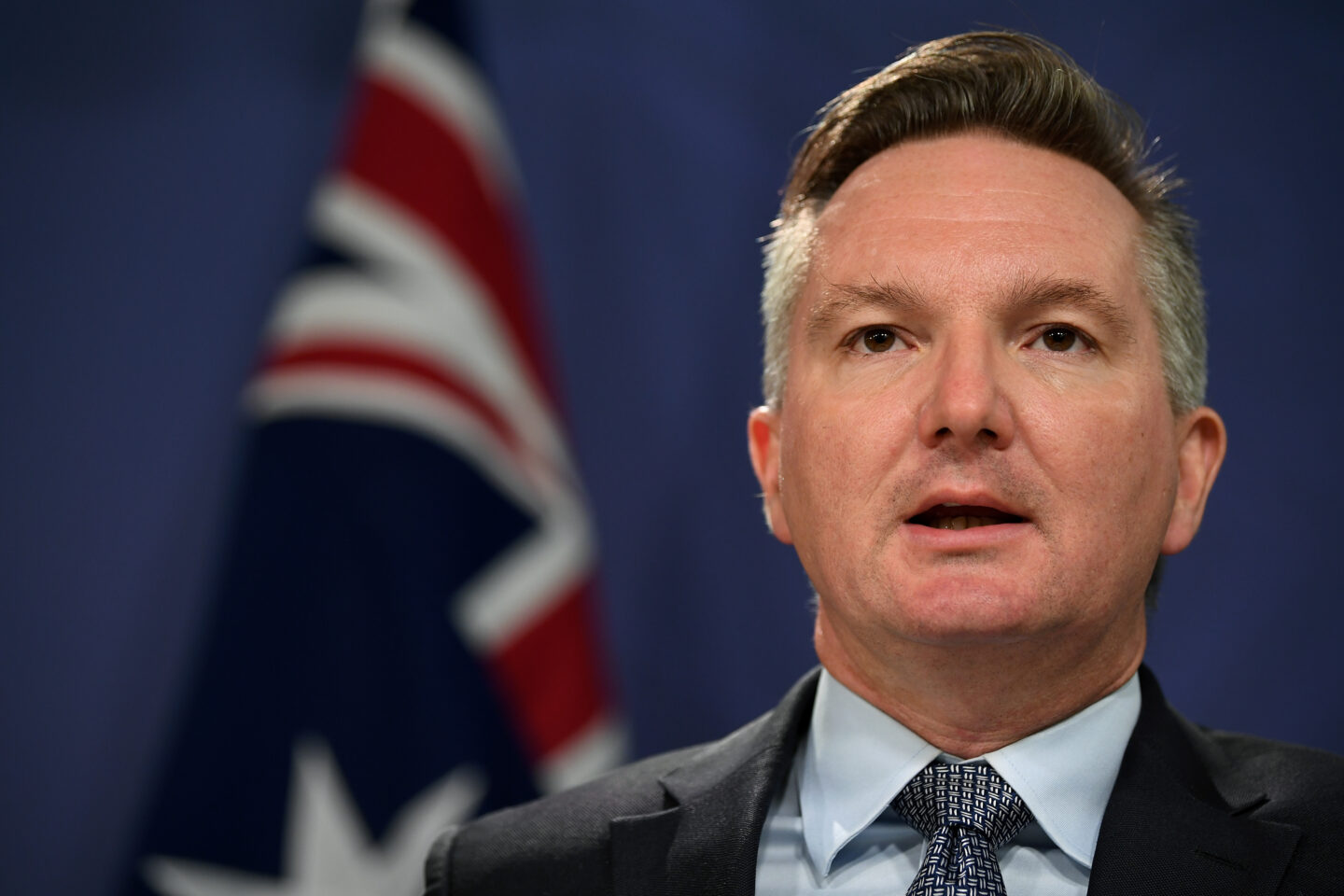
The post COP30 Bulletin Day 10: Germany pledges €1 billion to TFFF forest fund appeared first on Climate Home News.
COP30 Bulletin Day 10: Germany pledges €1 billion to TFFF forest fund
Climate Change
EU rift on fossil fuel roadmap threatens strong COP30 outcome
Resistance from Italy and Poland to a roadmap for a transition away from fossil fuels is blocking the European Union from adopting a joint position, complicating its stance in crunch talks over the main COP30 decision in Belém.
Climate Home News understands that internal discussions within the bloc are still ongoing as of Wednesday evening, aiming to persuade the two countries to support the plan in Belém and allow the EU to formally push for a roadmap in discussions.
One EU negotiator told Climate Home that if the bloc cannot agree to a united position on the roadmap, it cannot formally advocate for it in negotiations, putting at risk discussions over achieving a strong outcome on the transition away from fossil fuels.
More than 80 countries want COP30 to start a process for crafting a blueprint for the world to transition away from fossil fuels, which would put the landmark COP28 deal into practice. Supporters of the idea include 25 EU member states, excluding Poland and Italy.
Calls to broaden support
EU Commissioner for Climate Wopke Hoekstra said on Wednesday morning that “we very much like it, even though we might not use the word roadmap in Europe”.
He added that the EU had spent “a lot of time consulting with others to make the group, across the globe, that can accept it as broad as possible, as large as possible”.
The EU Commission and the country holding its rotating presidency – currently Denmark – negotiate at COP30 on behalf of all of the bloc’s member states. Its general negotiating position for the UN climate summit was set by ministers from all 27 member states at the end of October.
They agreed to “reiterate the call for transitioning away from fossil fuels in energy systems” – the language of the COP28 deal in 2023 – and to call on countries, “particularly major emitters, to operationalise their contribution to the call”. But the mandate to the negotiating team does not include specific references to a roadmap.
The idea was first floated by Brazilian Environment Minister Marina Silva in June, but it has only been gathering momentum since governments arrived in the Amazon city for COP30. Rapid developments over the past ten days have caught many countries off guard.
Pushback from petrostates
A draft “Mutirão” decision – expected to be the main political outcome of the Belém summit – published on Tuesday morning mentions the transition away from fossil fuels among a wide sweep of options for how to find agreement on the thorniest issues.
One option would encourage governments to convene a roundtable aimed at supporting countries to develop “just, orderly and equitable transition roadmaps”, including for reducing dependency on fuels and stopping deforestation. However, that appears to refer to domestic blueprints and stops short of advocating for a global roadmap that over 80 countries are calling for.
COP30 president André Corrêa do Lago said on Tuesday evening that the text “opens the door” between two “extremes”. “Most of the countries are either very favourable [to the fossil fuel roadmap] or it is a red line,” he added.
Petrostates within the Arab group, led by Saudi Arabia, previously pushed back against following up to the Dubai deal and are expected to mount strong opposition against efforts to include reference to a roadmap in the text.
Not a “top-down” process
A Polish negotiator declined to comment on the matter, citing ongoing talks.
Early in November, Poland was among a handful of countries that opposed a new EU target to cut emissions 90% by 2040, from 1990 levels, which was adopted by the bloc through majority voting, Reuters reported.
A spokesperson for the EU Commission declined to comment.
Jennifer Morgan, climate envoy for Germany until earlier this year, told Climate Home News that supporting a roadmap to transition away from fossil fuels is clearly in the EU’s interest.
“Policy to support such a roadmap… is already in many directives, and you see the growth of renewables. And so I would expect them to throw their full weight into this,” she said.
She added that as the process is meant to be something that is “nationally determined” and “not some top down thing that’s coming to tell them to do something different than what they already have in law, I would expect that they could support it.”
The post EU rift on fossil fuel roadmap threatens strong COP30 outcome appeared first on Climate Home News.
EU tables proposal for COP30 fossil fuel roadmap after settling internal rift
Climate Change
COP30 Bulletin Day 9: China and Russia oppose critical minerals mention in draft text
After Brazil’s COP30 presidency insisted on its plan to gavel through a political package on some of the most divisive issues at the UN climate talks “very late” on Wednesday, promised new draft texts had yet to materialise by early evening.
Brazilian President Luiz Inácio Lula da Silva is in town for a series of high-level meetings, including talks with delegations from the EU and China. UN Secretary-General António Guterres is also conducting bilateral engagements on the sidelines.
Key sticking points – from trade and finance from developed countries to a proposed roadmap for transitioning away from fossil fuels – remain unresolved. Brazilian negotiators are pushing to bridge divisions in hopes of securing an early win.
China and Russia oppose critical minerals in draft
Minerals needed for the transition from fossil fuels to clean energy systems made their first appearance in a draft COP text last week. But not everyone is happy about it.
Observers at the talks say China has opposed the inclusion of language on minerals in the text on ensuring a just energy transition within and among countries, while one with access to the negotiation rooms told Climate Home News that Russia is also resisting.
The current draft text for an area of the negotiations known as the Just Transition Work Programme (JTWP) includes an option to recognise the social and environmental risks from extracting minerals needed to manufacture batteries, solar panels and wind turbines. If adopted it would be the first mention of energy-transition minerals in the UN climate regime.
The same option also recalls principles and recommendations outlined by a UN of experts convened by UN Secretary General Antonio Guterres, which suggested that human rights must be “at the core” of mining for transition minerals.
Observers say China has been adamant about dropping all references to critical minerals in the COP30 draft. Russia took particular aim at the reference to the UN panel and wants it removed.
COP30 draft text includes energy transition minerals in UN climate first
To pressure China away from its current position, a group of activists sought to approach China’s second-in-command at COP30, Xia Yingxian, director general of the Department of Climate Change at China’s Ministry of Ecology and Environment (MEE).
After he concluded an appearance in an unrelated event at the WWF pavilion, a group of activists approached Xia to give him a letter “respectfully” calling on China to agree to the inclusion of minerals in the text, arguing that “China’s support would carry significant weight” and signal climate leadership.
“The explicit inclusion of critical energy transition minerals is a paramount priority for key delegates and partners across the Global South and developing parties here at COP30,” the letter read.
After being offered the letter, Xia rejected the document several times and, after the activists insisted, he sped away towards delegation offices.


China is a dominant actor in the transition minerals supply chain, producing more than 70% of the world’s refined lithium, 78% of the world’s refined cobalt and 91% of rare earth minerals, according to the International Energy Agency (IEA).
China wants a transition towards renewables
Battling the deafening roar of pouring rain in a remote corner of the COP venue, Xia Yingxian, director general of China’s Department of Climate Change, dropped subtle hints on where the country stands on the transition away from fossil fuels.
Speaking in English at the WWF pavilion, Yingxian said “we are trying to push for a transition to renewables, transitioning away from fossil fuels…how to make it just, orderly and fair. We understand it’s not easy, but this is the journey we have to go together.”
He suggested that, while there has been lots of talk about transitioning away, “such kind of narrative” could be reframed to overcome divisions.
How could we promote renewables? Trying to change the tone from negative to positive. This will be more than welcome,” he added.
Xia concluded his speech saying that a change in framing to “positive prosperity” could help “unite all of us” and send the message that “we can do it together”. He added the framing should not be about “losing” but “how we can win”.
China – the world’s largest producer of solar and wind technologies – has so far not publicly voiced a position on calls for a roadmap to transition away from fossil fuels at COP30.
Yesterday, more than 80 countries asked that a process to craft a roadmap to shift the world away from oil, coal and gas be agreed as one of the main outcomes from Belém.


Roadmap to end deforestation lags fossil fuel plan at Amazon COP
As countries ramp up pressure for a COP30 decision on a roadmap to transition away from fossil fuels, they have yet to push hard in the Amazon city of Belém for another much-anticipated roadmap to end deforestation.
Discussions on both mechanisms took off after Brazilian President Luiz Inácio Lula da Silva told world leaders at the summit’s opening that COP30 must deliver “roadmaps to plan in a fair way the reversal of deforestation, reducing the dependency on fossil fuels and to mobilise the necessary resources to reach these objectives”.
Since then, more than 80 countries have rallied behind a fossil fuel transition roadmap – yet negotiators from tropical countries and observers say a roadmap to end deforestation has not gained the same momentum at the UN climate talks.
At least 42 countries have expressed support for a deforestation roadmap – among them the European Union, the AILAC group of Latin American countries and the Environmental Integrity Group which includes Mexico, Liechtenstein, Monaco, South Korea, Switzerland and Georgia.
World failing on goal to halt deforestation by 2030, raising stakes for Amazon COP
Current negotiating drafts include an option to convene a dialogue of ministers on the creation of national roadmaps to end deforestation, which observers told Climate Home News is a weak option that must be improved with more pressure from countries.
Panama’s head of delegation Juan Carlos Monterrey told an event hosted by Climate Home News this week that a plan to protect forests has to be one of the key outcomes of COP30. “If we don’t get a roadmap to end deforestation at the Amazonia COP, we will never get it,” he said.
Latin America issues joint call for adaptation indicators in Belém
Latin American countries in the AILAC group advocated for a strong adaptation outcome at COP30, after African countries called for a two-year delay in the adoption of metrics to track climate resilience – a key deliverable at the summit.
Countries are discussing a set of indicators under the Global Goal on Adaptation (GGA), which they are expected to use to track progress on how they are coping with the impacts of climate change. But African countries want to hold off unless developed countries agree to triple adaptation finance to $120 billion a year by 2030, saying the metrics are meaningless without money to help them ramp up resilience.
Poorest countries appeal for more adaptation finance at COP30
The current draft texts of the “Mutirão” pact – the main expected outcome at COP30 – and the GGA both include options to establish a finance goal for adaptation. COP30 president André Correa do Lago said the two decisions are “interlinked”.
“It’s very important that we finish the indicators here. We’ve had two years of work. Technical teams have made progress on a list. It’s not perfect – nothing is – but it exists. We need that list approved so we can begin to implement it,” said Chile’s Environment Minister Maisa Rojas.
“We can’t leave a Latin American COP here in Belém without that set of indicators that can help us make progress in this area,” she added.


As dozens of reporters surrounded the group of Latin American ministers in an impromptu press huddle, the heads of delegation reiterated the need for finance to back up those indicators, which the Least Developed Countries (LDCs) appealed for on Tuesday.
Edwin Castellanos, environment minister of Guatemala, said vulnerable countries “cannot keep adapting with our own resources”, adding that developed countries must provide accessible finance.
“We cannot keep waiting for years while projects are developed and our communities keep suffering the impacts of climate change,” he said.
A UN report issued in the run-up to COP30 said developing countries will need to spend between $310 billion and $365 billion per year on measures to adapt to worsening climate change impacts by 2035.
Rojas of Chile said “we must ensure that finance reaches communities”, adding that one option would be to allocate a share of last year’s finance goal agreed in Baku for adaptation. It promises to mobilise $300 billion a year by 2035 in public finance for climate action in developing countries.
This is the preferred option of European countries, which have opposed reopening finance talks in Belem.
Gender Action Plan negotiations still haggling over definitions
The latest draft of the Gender Action Plan (GAP) was released yesterday and has six footnotes, four of them about the mere definition of gender. They were added by Paraguay, Argentina, Iran and the Vatican.
There are also two placeholders for footnotes from Indonesia, also related to the same topic. Climate Home News understands that, even if Russia doesn’t have a footnote to its name, it is one of the main countries pushing for the use of “women and girls” instead of the word “gender”. Other blockers include Saudi Arabia and Iran.
“We’ve always had fights on the Gender Action Plan… but this is different. This is trying to actually push women back by having this binary definition,” said Mary Robinson, former Irish president who is now a member of the Elders. “It’s so cruel. I mean, it’s actually unbelievable that this would enter into our space.”
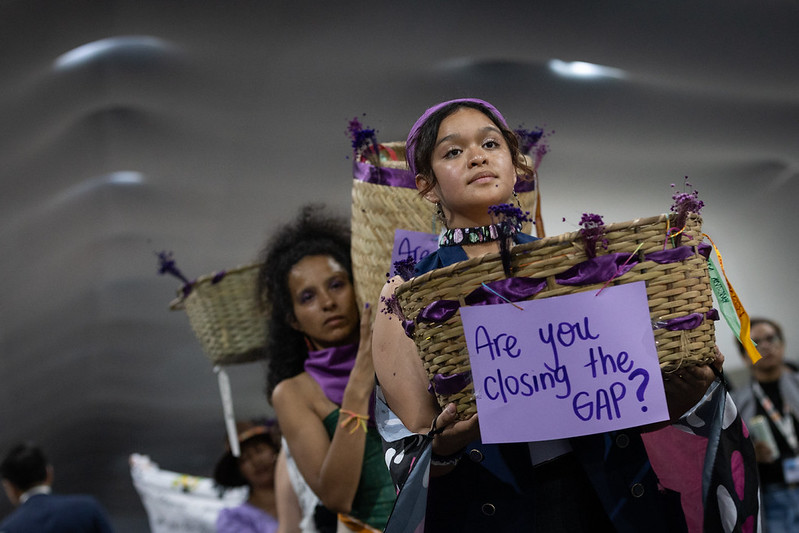
Campaigners say that this row over gender hasn’t been limited to the GAP negotiations, but forms part of a bigger, coordinated effort to backtrack on human rights language. A recent press release by the Women and Gender Constituency shows that gender references have received pushback in the negotiations on adaptation, mitigation, the Global Stocktake of climate action and the Green Climate Fund.
Bridget Burns, from the Women’s Environment and Development Organization (WEDO), told a press conference that in the past two years those wanting to undermine gender progress have been “emboldened by elections around the world that have shifted countries to the right”, including in the US election. In turn, she added that has triggered “a much stronger and more coordinated pushback to the pushback.”
On day one of COP, 92 countries signed a “Global Statement on Gender Equality and Climate Action Ahead of COP30”, reaffirming their commitment to a strong GAP, “because there was an awareness of what we might face in this process,” said Burns.
As the days went by and the negotiations seemed to unfold in a more or less peaceful way, the “Belém GAP” was supposed to appear on the first “Mutirão” decision package, but in the end it was left out as COP30 President André Correa do Lago said it was not directly related to the issues addressed in that planned decision. The topic is now being discussed in consultations led by ministers, as with other negotiating tracks.
“I would like to remind President Lula and the negotiators from Brazil that President Lula was mainly elected by women in this country,” said Michelle Ferreti, founder of the Brazilian Instituto Alzira. “It’s time to honour those who put them into power.”
The post COP30 Bulletin Day 9: China and Russia oppose critical minerals mention in draft text appeared first on Climate Home News.
COP30 Bulletin Day 9: Belém package elusive as Lula steals the show
-
Climate Change3 months ago
Guest post: Why China is still building new coal – and when it might stop
-
Greenhouse Gases3 months ago
Guest post: Why China is still building new coal – and when it might stop
-
Climate Change2 years ago
Spanish-language misinformation on renewable energy spreads online, report shows
-

 Greenhouse Gases1 year ago
Greenhouse Gases1 year ago嘉宾来稿:满足中国增长的用电需求 光伏加储能“比新建煤电更实惠”
-
Climate Change Videos2 years ago
The toxic gas flares fuelling Nigeria’s climate change – BBC News
-

 Climate Change1 year ago
Climate Change1 year ago嘉宾来稿:满足中国增长的用电需求 光伏加储能“比新建煤电更实惠”
-

 Carbon Footprint2 years ago
Carbon Footprint2 years agoUS SEC’s Climate Disclosure Rules Spur Renewed Interest in Carbon Credits
-
Renewable Energy4 months ago
US Grid Strain, Possible Allete Sale

